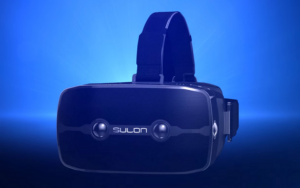AMD introduced a prototype of Sulon’s wireless HMD (Sulon Shows Cortex AR/VR Headset) at a private event at the Game Developers Conference last month, which we were alerted to be our friend Jon Peddie. Although we have seen news about the headset before, this was the first time that it had been shown to the public.
The Sulon Q is used for augmented and virtual reality. It is not tethered to a PC (unlike the HTC Vive or Oculus Rift), and uses an OLED display with 2560 x 1440 resolution and a 110° field of view.
Being shown at an AMD event, the headset naturally makes heavy use of the firm’s products. It features a quad-core FX-8800P APU and octa-core Radeon R7 graphics, as well as AMD’s LiquidVR system. LiquidVR is a bundle of different technologies that aim to make VR more realistic; one of the main goals is to reduce processing latency and deliver consistent frame rates.
The APU and GPU work together using AMD’s Heterogenous System Architecture. They can share memory and work together to raise performance and efficiency. New APIs, including DirectX 12 and Vulkan, can be used on the headset.
The untethered nature of the product and lack of external tracking mechanisms are a couple of the features that set it apart from the competition. The other main difference is its mix of augmented and virtual reality (AR/VR), using Sulon’s ‘Spatial Processing Unit’. This is described as ‘a mixed reality spatial computer that provides real-time environment mapping and tracking from the inside outward, dynamic virtualisation for VR/AR fusion and gesture recognition’. Environments are mapped in real-time by the SPU. This data is then sent to the AMD processor to produce “console-quality” graphics.
In conjunction with Windows 10, spatial computing will fulfil one of the promises of Microsoft’s own Hololens headset: placing applications in the real world. Sulon says that virtual applications can be placed in living areas. These can be transparent or opaque, and controlled through gestures or using the included wireless keyboard and mouse.
Sasa Marinkovic is head of software and VR marketing for AMD. He said that the spatial mapping technology scans the environment and users’ gestures in real time. They are then virtualised, to enable interaction.

